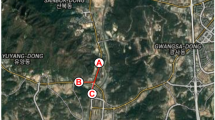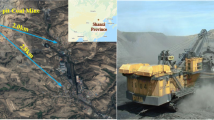Abstract
Methane is a kind of harmful gas produced in the process of coal mining. Because of its flammable and explosive characteristics, it poses a great threat to safety during coal mining. In practice, accurate and real-time gas concentration forecasting is becoming an essential issue for reducing methane risks and accidents. Given the complex spatial correlation and temporal variation of sensor data in a coal mine monitoring system, deep learning algorithms have been widely applied due to their revolutionary feature representation capability. However, existing deep learning models utilize recurrent neural networks, which can barely provide satisfactory accuracy due to their ignorance of realistic working conditions of a coal face or an insufficiency in capturing representative spatio-temporal patterns. In this paper, we propose an attention-based spatio-temporal encoder–decoder network approach, named the ASTED model, for methane concentration forecasting. The ASTED model is built based on the integration of the spatial, temporal and environmental information. Specifically, the multi-attention mechanism is used to learn the dynamic spatio-temporal dependencies, and the feature fusion module is used to incorporate the data from different mine sensors. Finally, we employ the LSTM-based encoder–decoder model to generate the final prediction results. Experiments demonstrate that the ASTED model can obtain the dynamic spatio-temporal correlation from multiple sensor readings and achieve the best performance compared with various state-of-the-art solutions.











Similar content being viewed by others
Data Availability
Not applicable.
Code Availability
Not applicable.
References
Bahdanau D, Cho K, Bengio Y (2014) Neural machine translation by jointly learning to align and translate. arXiv preprint arXiv:1409.0473
Cao J, Li WC (2017) Numerical simulation of gas migration into mining-induced fracture network in the goaf. Int J Min Sci Technol 27(4):681–685
Cheng J, Bai JY, Qian JS, et al (2008) Short-term forecasting method of coalmine gas concentration based on chaotic time series. Zhongguo Kuangye Daxue Xuebao 37
Cho K, Merrienboer BV, Gulcehre C, et al (2014) Learning phrase representations using rnn encoder-decoder for statistical machine translation. arXiv preprint arXiv:1406.1078
Dong DW, Li SG, Chang XT et al (2012) Prediction model of gas concentration around working face using multivariate time series. J Min Saf Eng 29(1):135–139
Fu H, Liu Y, Li H et al (2015) Short term forecasting model of gas concentration in coal mine using the capso-enn. Chin J Sens Actuators 28(5):717–722
Gao L, Hu YJ, Yu HZ (2008) Prediction of gas emission time series based on w-rbf. Mei T’an Hsueh Pao (Journal of China Coal Society) 33:60–70
Hochreiter S, Schmidhuber J (1997) Long short-term memory. Neural Comput 9(8):1735–1780
Jensen B, Gillies S, Jones N et al (1992) Review of methane emission and prediction research in longwall coal mines. Aust Inst Min Metall Proc 1:11–17
Karacan CÖ, Ruiz FA, Cotè M et al (2011) Coal mine methane: a review of capture and utilization practices with benefits to mining safety and to greenhouse gas reduction. Int J Coal Geol 86(2–3):121–156
Kurnia JC, Sasmito AP, Mujumdar AS (2014) Cfd simulation of methane dispersion and innovative methane management in underground mining faces. Appl Math Model 38(14):3467–3484
Liang Y, Ke S, Zhang J, et al (2018) Geoman: multi-level attention networks for geo-sensory time series prediction. In: IJCAI, pp 3428–3434
Lu G, Li X, Zu B et al (2017) Research on time-varying series forecasting of gas emission quantity based on emd-mfoa-elm. J Saf Sci Technol 13(6):109–114
Lu P, Ma YG, Zhou XQ (2006) Research and application on dynamic forecasting model of gas consistence in top corner. J China Coal Soc 031(004):461–465
Lyu P, Chen N, Mao S et al (2020) Lstm based encoder-decoder for short-term predictions of gas concentration using multi-sensor fusion. Process Saf Environ Prot 137:93–105
Mnih V, Heess N, Graves A, et al (2014) Recurrent models of visual attention. In: Advances in neural information processing systems, pp 2204–2212
Ni X (2008) Forecasting of gas emissions based on chaotic time series. Sci Technol Inf 31:34+20
Noack K (1998) Control of gas emissions in underground coal mines. Int J Coal Geol 35(1–4):57–82
Pan J, Meng ZP, Liu YC (2003) Grey smoothing model for predicting mine gas emission. J China Univ Min Technol 13(1):76–78
Qiao MY, Ma XP, Lan JY et al (2011) Time series short-term gas prediction based on weighted ls-svm. Caikuang yu Anquan Gongcheng Xuebao/Journal of Mining and Safety Engineering 28(2):310–314
Ślȩzak D, Grzegorowski M, Janusz A et al (2018) A framework for learning and embedding multi-sensor forecasting models into a decision support system: a case study of methane concentration in coal mines. Inf Sci 451–452:112–133
Song Y, Yang S, Hu X et al (2019) Prediction of gas and coal spontaneous combustion coexisting disaster through the chaotic characteristic analysis of gas indexes in goaf gas extraction. Process Saf Environ Prot 129:8–16
Sun X (2012) Coalmine gas prediction based on fuzzy neural network. J Anhui Univ Technol 29:229
Sutskever I, Vinyals O, Le QV (2014) Sequence to sequence learning with neural networks. In: Advances in neural information processing systems, pp 3104–3112
Tutak M, Brodny J (2019) Predicting methane concentration in longwall regions using artificial neural networks. Int J Environ Res Public Health 16(8):1406
Vaswani A, Shazeer N, Parmar N, et al (2017) Attention is all you need. In: Advances in neural information processing systems, pp 5998–6008
Wang K, Fu X, Zhou Y (2009) Dynamic development characteristics of amounts of gas and levels of pressure in the pan-1 coal mine of huainan. Min Sci Technol 19(6):740–744
Wang L, Cheng YP, Wang L et al (2012) Safety line method for the prediction of deep coal-seam gas pressure and its application in coal mines. Saf Sci 50(3):523–529
Wei Y, Lin BQ, Zhai C et al (2012) How in situ stresses and the driving cycle footage affect the gas outburst risk of driving coal mine roadway -sciencedirect. Tunn Undergr Space Technol 31:139–148
Williams BM, Hoel LA (2003) Modeling and forecasting vehicular traffic flow as a seasonal arima process: theoretical basis and empirical results. J Transp Eng 129(6):664–672
Wu J, Yuan S, Zhang C et al (2018) Numerical estimation of gas release and dispersion in coal mine using ensemble kalman filter. J Loss Prev Process Ind 56:57–67
Wu X, Qian J, Huang C et al (2014) Short-term coalmine gas concentration prediction based on wavelet transform and extreme learning machine. Math Probl Eng 2014:1–8
Xia T, Zhou F, Wang X et al (2016) Controlling factors of symbiotic disaster between coal gas and spontaneous combustion in longwall mining gobs. Fuel 182:886–896
Xia T, Zhou F, Wang X et al (2017) Safety evaluation of combustion-prone longwall mining gobs induced by gas extraction: a simulation study. Process Saf Environ Prot 109:677–687
Xu K, Ba J, Kiros R, et al (2015) Show, attend and tell: Neural image caption generation with visual attention. In: International conference on machine learning, PMLR, pp 2048–2057
Xu Q, Zhao J, Wang X (2010) Short-term prediction of coalmine gas concentration based on chaotic series and wavelet neural network. In: 2010 International conference on artificial intelligence and computational intelligence, IEEE, pp 240–244
Yu Q, Kai W, Yang S (2000) Study on pattern and control of gas emission at coal face in china. J China Univ Min Technol 29(1):9–14
Zhang JY, Cheng J, Hou YH et al (2007) Forecasting coalmine gas concentration based on adaptive neuro-fuzzy inference system. J China Univ Min Technol 36(4):494–498
Acknowledgements
This work was supported by National Natural Science Foundation of China (72271034) and BUPT Excellent Ph.D. Students Foundation (CX2021132).
Funding
National Natural Science Foundation of China (72271034); BUPT Excellent Ph.D. Students Foundation (CX2021132).
Author information
Authors and Affiliations
Corresponding author
Ethics declarations
Conflict of interest
No conflicts of interest and no computing interests.
Additional information
Publisher's Note
Springer Nature remains neutral with regard to jurisdictional claims in published maps and institutional affiliations.
Rights and permissions
Springer Nature or its licensor (e.g. a society or other partner) holds exclusive rights to this article under a publishing agreement with the author(s) or other rightsholder(s); author self-archiving of the accepted manuscript version of this article is solely governed by the terms of such publishing agreement and applicable law.
About this article
Cite this article
Gao, Y., Zhang, X., Li, Z. et al. An Attention-Based Spatio-temporal Model for Methane Concentration Forecasting in Coal Mine. Neural Process Lett 55, 4777–4798 (2023). https://doi.org/10.1007/s11063-022-11065-4
Accepted:
Published:
Issue Date:
DOI: https://doi.org/10.1007/s11063-022-11065-4




